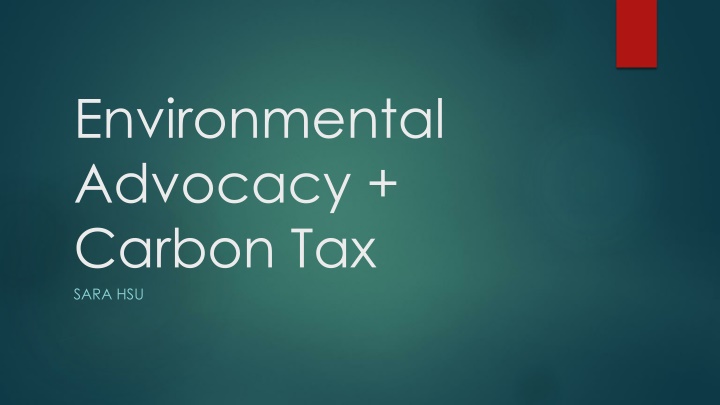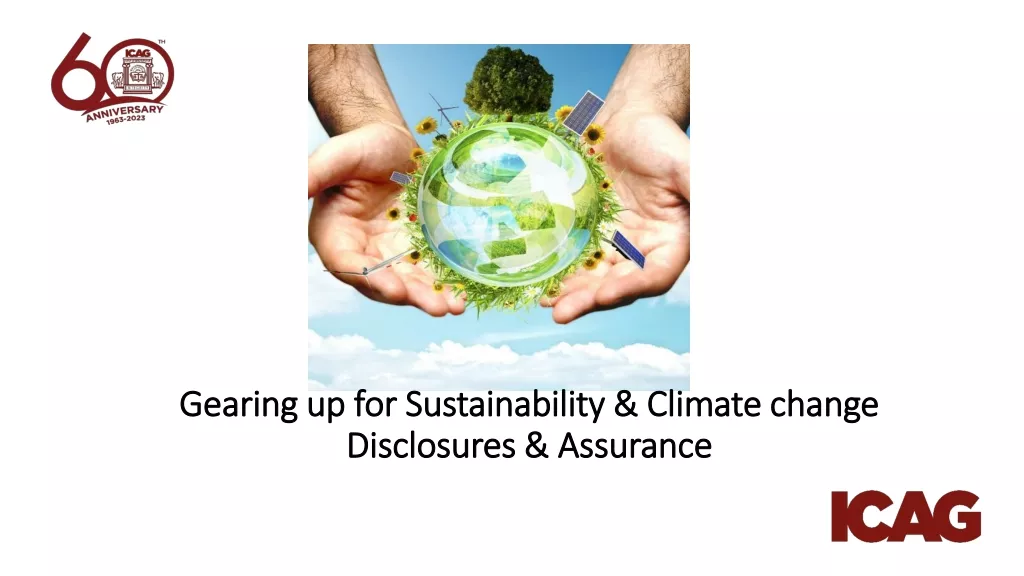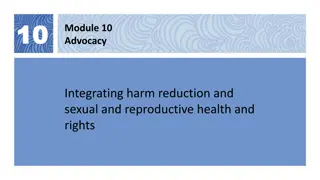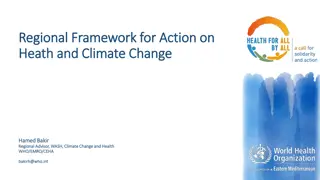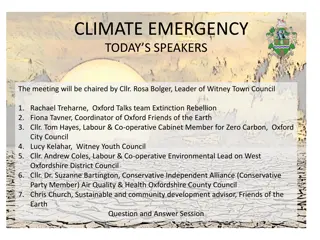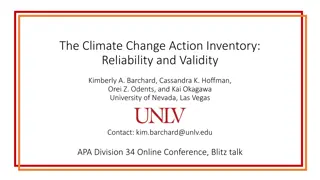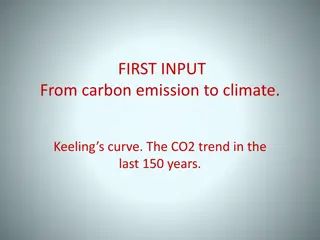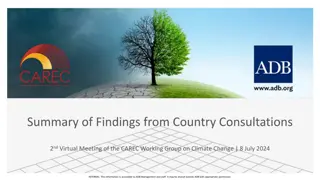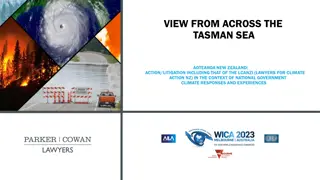Urgency of Environmental Advocacy and Climate Change Action
Environmental advocacy is crucial due to the pressing issue of climate change, as evidenced by rising global temperatures, sea levels, and extreme weather events. Urgent action is needed to address warming oceans, retreating glaciers, and increasing record high temperatures. Policy solutions focus on energy efficiency, renewable energy development, carbon pricing, and adaptation measures. The advocacy pathway involves information dissemination, modelling, lobbying, drafting legislation, and garnering support from legislators and the public.
Download Presentation

Please find below an Image/Link to download the presentation.
The content on the website is provided AS IS for your information and personal use only. It may not be sold, licensed, or shared on other websites without obtaining consent from the author.If you encounter any issues during the download, it is possible that the publisher has removed the file from their server.
You are allowed to download the files provided on this website for personal or commercial use, subject to the condition that they are used lawfully. All files are the property of their respective owners.
The content on the website is provided AS IS for your information and personal use only. It may not be sold, licensed, or shared on other websites without obtaining consent from the author.
E N D
Presentation Transcript
Environmental Advocacy + Carbon Tax SARA HSU
Environmental Advocacy Necessary for many reasons, most prominently because of climate change. Climate change has become a pressing problem. Pope Francis called for action on climate change, stating that it no longer be left to a future generation". President Obama said, we can choose to believe that Superstorm Sandy, and the most severe drought in decades, and the worst wildfires some states have ever seen were all just a freak coincidence, or we can choose to believe in the overwhelming judgment of science and act before it s too late.
Climate Change is Happening Scientific evidence for warming of the climate system is unequivocal. - Intergovernmental Panel on Climate Change Sea level rise: Global sea level rose about 17 centimeters (6.7 inches) in the last century. The rate in the last decade, however, is nearly double that of the last century. Global temperature rise: All three major global surface temperature reconstructions show that Earth has warmed since 1880.5Most of this warming has occurred since the 1970s, with the 20 warmest years having occurred since 1981 and with all 10 of the warmest years occurring in the past 12 years.6Even though the 2000s witnessed a solar output decline resulting in an unusually deep solar minimum in 2007-2009, surface temperatures continue to increase.
Warming oceans: The oceans have absorbed much of this increased heat, with the top 700 meters (about 2,300 feet) of ocean showing warming of 0.302 degrees Fahrenheit since 1969. Retreating Glaciers: Glaciers are retreating almost everywhere around the world including in the Alps, Himalayas, Andes, Rockies, Alaska and Africa. Extreme events: The number of record high temperature events in the United States has been increasing, while the number of record low temperature events has been decreasing, since 1950. The U.S. has also witnessed increasing numbers of intense rainfall. -NASA
Many Policy Solutions to Climate Change Centers on energy policy: Fuel economy and energy efficiency standards Renewable energy development Adaptation measures such as expansion of infrastructure, changing zoning regulations Carbon cap and trade systems and carbon taxes
Advocacy Pathway From information to modelling From modelling to reporting and publicizing Identifying appropriate legislators Lobbying and meeting Drafting legislation Getting the bill introduced Gathering support for the bill Lobbying and meeting Getting the bill through
Purpose of a Carbon Tax A carbon tax places a tax on fossil fuels produced or distributed in the area, based on how many metric tons of carbon are emitted into the atmosphere, and repays the tax to the consumer or producer through tax refunds or uses revenues for other purposes. The purpose of the policy is to send a price signal to consumers and producers that includes the cost of pollution, thereby changing consumer and producer behavior via economic incentives.
NYS Carbon Tax a Class Effort This workshop and the carbon tax effort in general grew out of an Economics class project at this university. We began to look at climate change solutions and, as a class, and realized that a carbon tax was among the most feasible solutions across the globe. Takeaway is that students and young people in general care about climate change and need a clear outlet through which to express their concerns.
NYS Economists Support a Carbon Tax Marco Battaglini, Cornell University Kaushik Basu, Cornell University Ben Ho, Vassar College (at a lower level) Mona Ali, SUNY New Paltz Gary Fields, Cornell University Willi Semmler, New School Gerald Marschke, SUNY Albany Duncan Foley, New School Simin Mozayeni, SUNY New Paltz Sara Hsu, SUNY New Paltz Mark Gertler, NYU Thomas Sargent, NYU Michael Grossman, CUNY Raquel Fernandez, NYU (at a lower level) Graciela Chichilnisky, Columbia University Laura Veldkamp, NYU Sean MacDonald, CUNY Robert Frank, Cornell University (at a high level)
Governor David Patersons Pledge New York State Executive Order Number 24, laid out by New York Governor David Paterson in 2009, sets forth the goal to reduce greenhouse gas emissions in the state by 80% of 1990 levels by the year 2050--about 40 million metric tons. CO2 levels reached 187.57 million metric tons in 2010. New York State will in fact not reach a level of CO2 emissions 80% below 1990 levels by 2050 if the state does not continue to take serious action.
Proposed Carbon Tax A carbon tax imposed on crude oil and gasoline in New York State, at a rate equivalent to $180 per metric ton of carbon dioxide emitted, would generate revenue while addressing climate change. The tax currently proposed would start at $35, increasing $15 each year until reaching $180. 60% of revenues would be returned to low and moderate income households, while 40% would go to climate change adaptation, mass transit, and transition to renewable energy.
Impact of a Carbon Tax The carbon tax would dramatically reduce CO2 emissions, cutting them by over half. Carbon tax revenues would amount to over $14 billion. This would leave $5.6 billion to programs such as mass transit, climate change adaptation, and transition to renewable energy. $8.4 billion would be returned to the lowest income groups to shield them from the burden of the tax. Returning funds to the poor will shift their spending toward consumption of other goods and services. This in itself is job- creating.
New York is Transforming Energy New York State is already attempting to transform its energy sector by focusing on the following goals as part of its New York State Energy Plan for 2014: increasing energy affordability, enhancing private sector energy financing, strengthening the power grid, increasing customer control over energy use, and meeting energy innovation with market. The CO2 Tax policy on fossil fuels will help to further shift the energy landscape.
Costs of Climate Change are High One can contrast the impact of a carbon tax on the economic impact of Hurricane Sandy alone. While a carbon tax is predicted to generate revenue, switching spending from capital-intensive fossil fuel industries to labor-intensive consumer industries, failing to implement economic policies to reduce the impact of climate change will have serious economic consequences. During Hurricane Sandy, the New York City metro area lost 32,000 jobs in the immediate aftermath of the storm, particularly in the utilities, chemicals, food, transportation equipment and computers and electronic products sectors
Aim of the Workshop The aim of this workshop is to discuss how one can advocate for environmental causes in general, what past experiences have been like, and how the carbon tax specifically has been proposed and enacted. We welcome: Mark Dunlea, President of the Green Education and Legal Fund; Steve Breyman, Associate Professor of Peace, Environmental and Media Studies at Rensselaer Polytechnic Institute; Jannette Barth, President of J.M. Barth & Associates Inc.; and Charles Komanoff is Director of the Carbon Tax Center. The morning will consist of lectures from experienced NYS environmental advocates on advocacy and the carbon tax, while the afternoon is reserved for discussion about the NYS carbon tax. Lunch will be served from 12-1; we can also take a working lunch if so chosen to get a jump start on the afternoon session, and can end earlier than 4 pm if desired (perhaps 3 pm).
